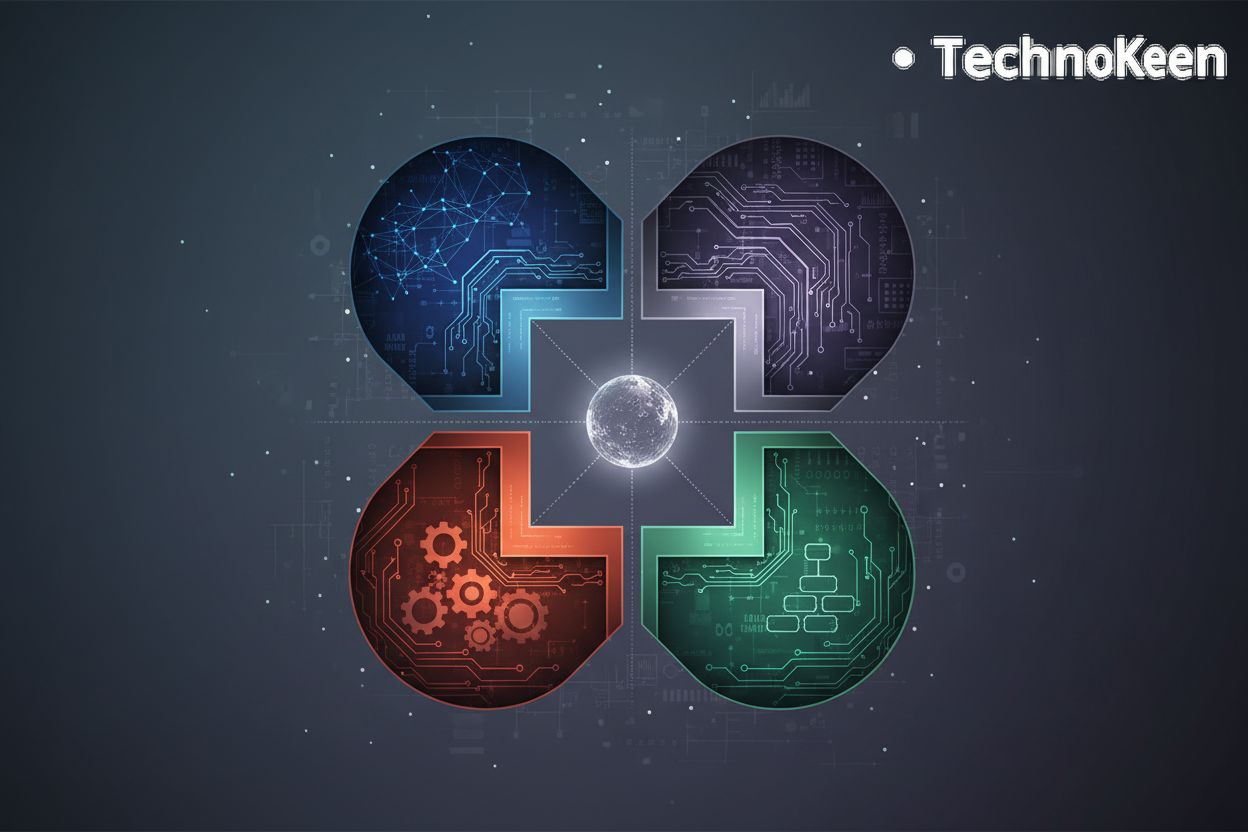AI Agent Identity Federation Patterns: Secure and Scalable AI Solutions for the Enterprise
TL;DR
Understanding AI Agent Identity and Access Management (IAM)
AI agents are revolutionizing enterprise workflows, but securing these intelligent systems requires a new approach to identity and access management. Traditional IAM systems often fall short when it comes to handling the unique challenges posed by AI agents.
AI agents are rapidly becoming essential in various industries. (AI Agents: What They Are and Their Business Impact | BCG) For example, in healthcare, they assist with diagnosis and treatment planning. (The Role of AI in Hospitals and Clinics: Transforming Healthcare in ...) Think of retail, they optimize inventory management and personalize customer experiences. (AI in Retail) Securing these agents is paramount.
Traditional IAM systems are often inadequate for AI agents. These systems were not designed to manage the complex interactions and permissions required by AI-driven systems. This is because AI agents require access to diverse data sources and APIs.
Identity federation offers a solution by enabling secure and scalable access across different AI agent platforms and services. It ensures that agents can securely access the resources they need, regardless of where those resources are located. Identity federation creates a unified identity for each agent, simplifying access management and enhancing security.
Authentication verifies the identity of AI agents. It prevents unauthorized access to sensitive data and systems. Strong authentication mechanisms, such as multi-factor authentication, should be implemented to ensure only legitimate agents gain access.
Authorization defines and enforces access policies based on agent roles and permissions. Role-Based Access Control (RBAC) can be used to assign specific permissions to different types of agents. This ensures that agents only have access to the resources they need to perform their tasks.
Auditability tracks agent activities to ensure compliance and detect security breaches. Audit trails provide a record of all actions taken by an agent, which can be used to identify and investigate suspicious behavior. Regular audits help organizations maintain compliance with industry regulations.
Understanding these core IAM principles is crucial for building secure and scalable AI solutions. In the next section, we will explore common AI agent identity federation patterns.
Core AI Agent Identity Federation Patterns
AI agents are rapidly changing how enterprises operate, but ensuring secure access across different systems is a complex challenge. Fortunately, identity federation patterns provide a blueprint for managing AI agent identities in a scalable and secure manner.
AI agents often need to interact with resources across different security domains. Trust delegation allows an agent in one domain to securely access resources in another without directly sharing credentials. This is especially important in multi-cloud or hybrid environments.
- Secure Access: Agents can access necessary resources without exposing sensitive credentials.
- Simplified Management: Centralized control over access policies reduces administrative overhead.
- Compliance: Ensures adherence to security policies across different domains.
Protocols like OAuth 2.0 and SAML are commonly used for trust delegation. These protocols establish a secure channel for exchanging authentication and authorization information. This ensures that only authorized agents can access protected resources.
mermaid
graph LR
A[Identity Provider 1] --> B(Identity Mapping Service)
C[Identity Provider 2] --> B
B --> D{AI Agent}
style D fill:#f9f,stroke:#333,stroke-width:2px
**Token exchange** allows an AI agent to exchange a security token issued by one identity provider for a token valid for another. This pattern is useful when agents need to access resources protected by different token formats or security policies. The Security Token Service (STS) pattern is often used to implement token exchange.
- Enhanced Security: Agents can securely access resources without exposing credentials.
- Flexibility: Supports different token formats and security policies.
- Scalability: Enables secure access to a large number of resources.
AI agents can seamlessly access resources protected by different security policies.

Understanding these core identity federation patterns is essential for building secure and scalable AI solutions. In the next section, we will delve into advanced patterns for managing AI agent identities.
Implementing Identity Federation in AI Agent Workflows
AI agents streamline operations, but how do you ensure they're accessing the right resources securely? Identity federation patterns offer a solution, and implementing these patterns effectively is key to a secure and scalable AI infrastructure.
Single Sign-On (SSO) simplifies the authentication process for AI agents. It allows them to access multiple applications and services with a single set of credentials. This not only enhances agent usability but also reduces the risk of credential sprawl, where multiple sets of credentials increase the attack surface.
- SSO streamlines authentication, making it easier for AI agents to access different resources. Agents can perform tasks more efficiently without needing to re-authenticate for each application.
- Protocols like SAML and OpenID Connect (OIDC) are commonly used to enable SSO for AI agents. These protocols establish a secure and standardized way to exchange authentication and authorization information.
- SSO improves agent usability and reduces the risk of credential sprawl. By using a single set of credentials, agents can securely access multiple applications, simplifying access management and reducing administrative overhead.

Role-Based Access Control (RBAC) and Attribute-Based Access Control (ABAC) provide fine-grained control over AI agent access to resources. These models ensure that agents have the appropriate level of access based on their function and context.
- RBAC assigns permissions to agent roles, streamlining access management based on job function. For example, an AI agent responsible for data analysis might be assigned the "Data Analyst" role, granting it access to relevant data sources and analytical tools.
- ABAC uses attributes to define access policies, offering more dynamic and context-aware control Arts2Survive. This allows organizations to define policies based on a combination of agent attributes, resource attributes, and environmental conditions.
- These models ensure that agents have the appropriate level of access based on their function and context. Properly implemented RBAC and ABAC enhance security and compliance by ensuring agents only have the necessary permissions to perform their tasks.
Implementing identity federation patterns like SSO, RBAC, and ABAC is crucial for building secure and scalable AI agent workflows. Next, we'll explore advanced patterns for managing AI agent identities.
Security Considerations for AI Agent Identity Federation
AI agents are powerful tools, but with great power comes great responsibility. How can we ensure these agents operate securely within our enterprise environments?
AI agent credentials and keys must be securely stored and managed to prevent unauthorized access. This is crucial to maintain the integrity and confidentiality of the systems they interact with. Without robust protection, malicious actors could compromise agent identities and gain access to sensitive data.
Hardware Security Modules (HSMs) and secure enclaves can be used to protect sensitive cryptographic material. HSMs provide a tamper-resistant environment for storing and managing keys, while secure enclaves offer isolated execution environments for sensitive operations. This helps prevent unauthorized access to these critical components.
Regular rotation of credentials and keys is essential to mitigate the impact of potential breaches. By frequently changing these access components, organizations can limit the window of opportunity for attackers who may have compromised previous credentials. This proactive approach reduces the risk of long-term damage.
Identity spoofing and impersonation attacks can compromise AI agent ecosystems. These attacks involve malicious actors attempting to assume the identity of legitimate agents, potentially leading to unauthorized access and data breaches. Robust security measures are necessary to prevent such incidents.
Strong authentication mechanisms and mutual TLS can help prevent these attacks. Multi-factor authentication adds an extra layer of security, requiring agents to provide multiple forms of identification. Mutual TLS ensures that both the agent and the server verify each other's identities before establishing a connection.
Monitoring agent activity for suspicious patterns can also detect and respond to impersonation attempts. By analyzing agent behavior, such as access patterns and resource utilization, organizations can identify anomalies that may indicate malicious activity. Early detection enables prompt response and minimizes potential damage.
AI agents with privileged access require extra scrutiny and security measures. These agents have elevated permissions, making them attractive targets for attackers seeking to gain control over critical systems. Organizations must implement safeguards to limit the potential for misuse.
Just-in-time (JIT) access and break-glass procedures can limit the exposure of privileged credentials. JIT access grants agents temporary permissions only when needed, reducing the risk of long-term compromise. Break-glass procedures provide emergency access in exceptional circumstances, with strict controls and monitoring.
Regular audits and reviews of privileged agent access are crucial for maintaining security. These audits should examine access logs, permission assignments, and agent activities to identify any anomalies or potential vulnerabilities. This proactive approach helps ensure ongoing compliance and security.
Securing AI agent identity federation requires careful attention to credential protection, identity verification, and privileged access management. Next, we will discuss compliance and governance strategies for AI agent ecosystems.
Governance and Compliance in Federated AI Agent Environments
AI agent identity governance is essential for secure and compliant enterprise AI solutions. But how do you ensure these intelligent systems adhere to regulatory standards?
Clear identity governance policies are crucial for managing AI agent identities and access rights. These policies should define roles, responsibilities, and procedures for agent provisioning, deprovisioning, and access reviews. Well-defined governance policies ensure that AI agents operate within established boundaries.
- Role definitions clarify what each agent can and cannot do. For instance, an AI agent in finance might have the role of "transaction auditor," allowing it to review financial transactions but not approve them.
- Provisioning ensures that new agents are properly onboarded with appropriate access. Deprovisioning promptly removes access when an agent is no longer needed, reducing security risks.
Automated workflows can help enforce identity governance policies consistently. This minimizes manual errors and ensures that policies are followed uniformly across all AI agents.
AI agent identity federation must comply with data privacy regulations like GDPR and CCPA. These regulations set strict requirements for handling personal data, and AI agents must be designed to respect these rules.
- Data minimization ensures that AI agents only access the data they need. Anonymization techniques help protect sensitive information by removing personally identifiable details.
- Transparency is also key. Users should be informed about how AI agents process their data and have the ability to provide or withdraw consent.
Detailed audit trails are required for demonstrating compliance with regulatory requirements. These logs provide a record of all agent activities, which can be used to verify compliance and detect potential security breaches.
- Agent activities, including authentication events, access requests, and data modifications, should be logged. Audit logs should be securely stored and regularly reviewed for suspicious activity.
- Regular audits can help identify vulnerabilities and ensure that AI agents are operating in accordance with established policies. These audit trails are essential for demonstrating accountability and maintaining trust in AI systems.
As we’ve seen, governance and compliance are critical in federated AI agent environments. Next, we will explore best practices for AI agent deployment and orchestration.
Real-World Examples and Case Studies
AI agents are not just theoretical concepts; they're already transforming industries by automating complex tasks and improving decision-making. Let's look at some real-world applications of AI agent identity federation.
AI agents can revolutionize healthcare, but data security is paramount. Identity federation plays a crucial role in enabling secure data sharing across healthcare organizations.
- AI agents can be used to analyze medical data from multiple hospitals and research institutions. Identity federation ensures that only authorized agents have access to sensitive patient information. This allows researchers to gain insights from larger datasets while maintaining patient privacy.
- Identity federation enables secure data sharing while complying with HIPAA regulations. By implementing robust authentication and authorization mechanisms, healthcare providers can ensure that AI agents only access data in compliance with strict regulatory requirements. This is vital for maintaining patient trust and avoiding legal penalties.
- Federated learning techniques can be used to train AI models without centralizing sensitive data. Instead of sharing raw data, each institution trains its own model locally, and only the model parameters are shared. This approach enhances privacy and security while still allowing for the development of accurate AI models.
The finance industry faces constant threats from fraud, making secure AI agent access essential. AI agents can play a critical role in detecting and preventing fraudulent activities.
- AI agents can be used to detect fraudulent transactions and activities across different financial institutions. Identity federation allows these agents to securely access customer data from various sources, enabling them to identify patterns and anomalies that might indicate fraud. This is essential for protecting financial institutions and their customers from financial losses.
- Identity federation allows secure access to customer data while complying with PCI DSS standards. Financial institutions must adhere to strict security standards when handling customer financial data. Identity federation helps ensure that AI agents comply with these standards by providing secure and auditable access controls.
- Risk-based authentication can be used to verify agent identities and prevent unauthorized access. This approach assesses the risk associated with each access attempt and requires additional authentication factors for high-risk transactions. This adds an extra layer of security and helps prevent identity spoofing and impersonation attacks.
These examples highlight how identity federation enables secure and scalable AI solutions in highly regulated industries. As AI agents become more prevalent, robust identity management will be crucial for realizing their full potential. In the next section, we'll look at best practices for AI agent deployment and orchestration.
Best Practices and Future Trends
Implementing zero trust and exploring decentralized identity are key to future-proofing AI agent security. These strategies ensure robust, scalable AI solutions for enterprises.
Zero trust mandates verifying every agent, regardless of network location. It enhances security by minimizing implicit trust.
Microsegmentation limits breach impact through granular access control. Continuous monitoring detects and responds to suspicious activities.
Least privilege access restricts agent permissions to essential tasks. This reduces the potential damage from compromised agents.
Decentralized identity, using blockchain, enhances security and privacy. It provides a tamper-proof, auditable identity management system.
Agents utilize decentralized identifiers (DIDs) to manage credentials independently. This eliminates reliance on centralized authorities.
Verifiable credentials prove agent attributes without central validation. This establishes trust through cryptographic proofs.
As AI agents evolve, these security practices will become increasingly crucial.




